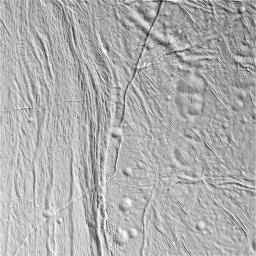
|
Transition on Enceladus
- Click the image above for a larger view
- Full-Res JPEG (1024 x 1024) (202.0 kB)
- Full-Res TIFF (1024 x 1024) (1.1 MB)
Caption:
This view of Saturn's moon Enceladus shows an area that has undergone a very intriguing -- and in places puzzling -- sequence of events. The craters here are subdued, as seen elsewhere on Enceladus, and most, but not all, are older than the fractures. Fracturing has occurred at a wide variety of scales, from the wide rift running through the center of the image to much narrower sets of shorter fractures that crosscut the craters (and each other) to the left.
The image has been rotated so that north on Enceladus is up.
This region is a transition from cratered to wrinkled terrain. Westward (left) of the central rift that divides the two regions are relatively parallel grooves and ridges that are reminiscent of terrain on Jupiter's large moon Ganymede. Very few craters are seen in this area of Enceladus. Eastward (right) of the large rift the terrain becomes more cratered, although the craters are quite degraded (meaning soft and shallow in appearance).
A prominent fracture runs north-south to the center of the image, then turns sharply to the southwest, cutting across cratered terrain, the large rift, and the grooved terrain. This behavior signifies that it is one of the youngest features in this image.
The image was taken in visible light with the narrow angle camera from a distance of about 14,000 kilometers (8,800 miles) and from Enceladus and at a Sun-Enceladus-spacecraft, or phase, angle of 44 degrees. Pixel scale in the image is about 85 meters (280 feet) per pixel.
A stereo version of the scene is also available (see PIA06214 ). The images have been contrast-enhanced to aid visibility.
Background Info:
The Cassini-Huygens mission is a cooperative project of NASA, the European Space Agency and the Italian Space Agency. The Jet Propulsion Laboratory, a division of the California Institute of Technology in Pasadena, manages the mission for NASA's Science Mission Directorate, Washington, D.C. The Cassini orbiter was designed, developed and assembled at JPL. The magnetometer team is based at Imperial College in London, working with team members from the United States and Germany.
For more information about the Cassini-Huygens mission visit http://saturn.jpl.nasa.gov . The magnetometer team homepage is http://www.imperial.ac.uk/research/spat/research/cassini/ .
Cataloging Keywords:
| Name | Value | Additional Values |
|---|---|---|
| Target | Enceladus | Ganymede |
| System | Saturn | Jupiter |
| Target Type | Satellite | |
| Mission | Cassini-Huygens | |
| Instrument Host | Cassini Orbiter | |
| Host Type | Orbiter | |
| Instrument | Imaging Science Subsystem (ISS) | |
| Detector | Narrow Angle Camera | |
| Extra Keywords | Crater, Grayscale, Rotation, Visual | |
| Acquisition Date | ||
| Release Date | 2005-03-24 | |
| Date in Caption | ||
| Image Credit | NASA/JPL/Space Science Institute | |
| Source | photojournal.jpl.nasa.gov/catalog/PIA06215 | |
| Identifier | PIA06215 | |
